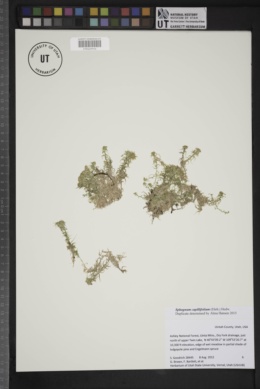Sphagnum capillifolium
|
|
|
|
Family: Sphagnaceae
|
Plants small to moderate-sized, compact to fairly slender, normally stiff and erect; capitulum typically hemispherical; in exposed sites red, mottled red and green, in shaded sites green forms are common; without metallic lustre when dry. Stems green to red; superficial cortical cells aporose Stem leaves lingulate-triangular, 1.2-1.6(-1.8) mm, apex ± involute; border entire and broadened to about 0.25 the width of the base; hyaline cells S-shaped, 0-1-septate, usually fibrillose in distal portion of leaf. Branches not 5-ranked, terete. Branch fascicles with 2 spreading and 1-2 pendent branches. Branch leaves ovate-lanceolate, 1-1.4 mm, imbricate to moderately spreading, concave, straight, strongly involute near apex; hyaline cells on convex surface with elliptic pores along commissures, concave surface with large round pores away from commissures in proximal portions of leaf. Sexual condition dioicous. Spores 20-28 µm; finely papillose on both surfaces, with distinct raised Y-shaped sculpture on distal surface; proximal laesura 0.5 spore radius or more. Capsules mature mid summer. Ombrotrophic, broad range of acidic environments, also forming dense mats and carpets over wet, acidic rocks and peat, especially at higher elevations, less frequent in forested fen vegetation; low to high elevations; Greenland; Alta., B.C., Man., N.B., Nfld. and Labr. (Nfld.), N.W.T., N.S., Nunavut, Ont., P.E.I., Que., Sask., Yukon; Alaska, Calif., Conn., Idaho, Ill., Ind., Ky., Maine, Mass., Mich., Minn., Mont., Ohio, Oreg., Pa., R.I., S. Dak., Tenn., Vt., Va., Wash., W.Va., Wyo.; Europe. Sporophytes are fairly common in Sphagnum capillifolium. This species is most common and abundant in ombrotrophic heath vegetation associated with S. angustifolium, S. fallax, S. fuscum, S. magellanicum, S. rubellum, Polytrichum commune, and P. juniperinum. It can be distinguished from most other red species of sect. Acutifolia with which it co-occurs by its lack of 5-ranking in the branches. Sphagnum subtile is a forest and non-hummock forming species that has a distinctly shorter and more triangular-lingulate stem leaf. The stem leaf border on S. subtile is also more strongly bordered. Sphagnum tenerum, which geographically overlaps S. capillifolium only very minimally, has much more turgid branches and a generally more robust look. The stem leaf of S. tenerum is triangular-lingulate as compared to the lingulate- triangular stem leaf of S. capillifolium. See also discussion under 84. S. subnitens and 87. S. tenerum. The names Sphagnum acutifolium Schrader and S. nemoreum Scopoli (doubtful name) have also been used for this taxon.
|

























